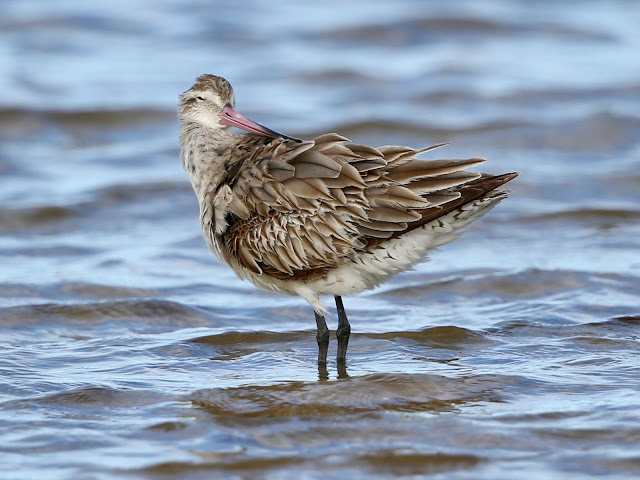An
opportunity to photograph some Bar-tailed Godwits (Limosa lapponica) unexpectedly presented on Lake Merimbula adjacent
to the busy Merimbula waterfront tourist precinct. The rising tide had pushed
the Bar-tails towards a line of fringing mangroves which gave them some
screening from people walking along the promenade, dining at the waterfront café
and accessing a busy carpark. No doubt the birds had become accustomed to the presence
of people in this uncommon situation.
About 40
Bar-tails had finished their morning low tide feeding session and as the tide then
flooded into the Lake, the birds were in bathing, preening and resting mode as
they stood in shallow water beside the receding sand flat. The rising tide
would soon see them fly to their high tide roosting location but for now they
seemed content where they were.
From a gap
in the mangroves I observed the birds and took photos of some individuals
preening, the only action, as most were sleeping or at least resting while
perched on one leg with their bills buried in their back feathers.
Please click on photos
to enlarge.
 |
| Most of the Godwits were resting or sleeping. |
The following
sequence of photos is of one bird preening.
 |
| Godwits mostly hold their necks in, so on the odd occasion when they are stretched out they appear to be surprisingly long. |
 |
| A brief rest from preening – I noticed that the preening bird regularly dipped its bill in the water to moisten it for preening purposes – I have not noticed this behaviour before. |
 |
| The baring of the tail is obvious in many of the preening photos. |
 |
| Mostly the bill is used for preening but the foot is used for an occasional vigorous scratch around the head and neck area where the bill can’t reach. |
I was not
sure if the 40 odd Bar-tails were recently returned to Australia from their
northern hemisphere breeding sites or were immature birds that remained in
Australia over our winter. Only one bird in the group had a significant amount
of breeding plumage however some immature birds remaining in Australia can put
on breeding plumage. Given only one bird had breeding plumage, it is likely
these were all immature non-breeding birds.
The following
sequence of photos is of the bird with breeding plumage. The chestnut or brick
red colour indicates this is a male bird as the head and body of the females in
breeding plumage is a deep buff colour.
 |
| Ruffling feathers after a bath. |
 |
| This bird has lost the tip of the lower mandible. |
At this
time of year and when the migrant shorebirds return from their breeding grounds
they undertake a full moult including the once a year moult of flight feathers.
Other feathers are moulted twice a year into and out of breeding colour.
 |
| This bird’s raised wings show the secondary flight feathers are missing, indicating moult is in progress. |
Lake Merimbula
is always worth a check for shorebirds, any time of year, and sometimes birds
can be seen at close range giving good photo opportunities.



















No comments:
Post a Comment